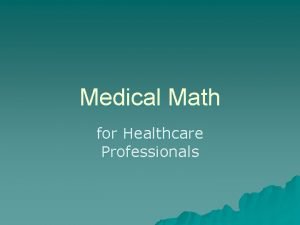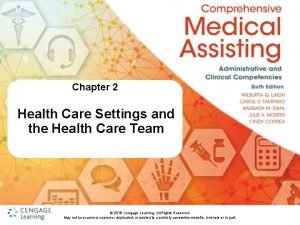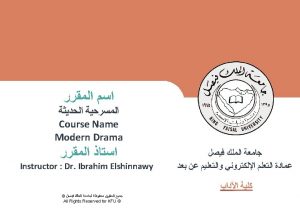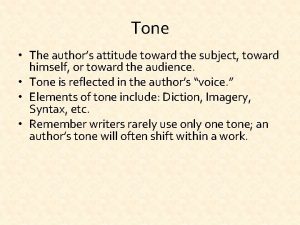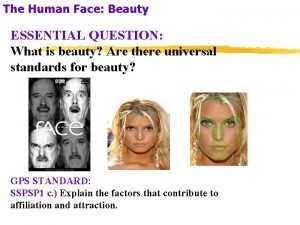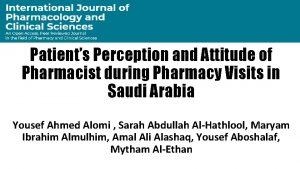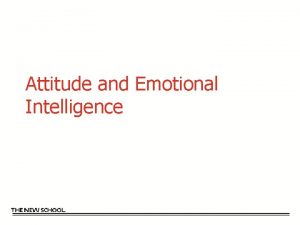Healthcare Professionals Perception and Attitude toward Pharmacist during







- Slides: 7

Healthcare Professional’s Perception and Attitude toward Pharmacist during Pharmacy Visit in Saudi Arabia Yousef Ahmed Alomi, Sarah Abdullah Al-Hathlool, Maryam Ibrahim Almulhim, Amal Ali Alashaq, Yousef Aboshalaf, Mytham Al-Ethan

ABSTRACT: Purpose: To explore the healthcare professional’s perception and attitude toward pharmacist during pharmacy visit in Saudi Arabia. Methods: This is a 4 -month cross-sectional survey of the healthcare professional’s perception toward pharmacist. The survey consisted of two parts: the first part collects demographic information and the second part has 49 questions divided into four domains: (1) the first domain captures information regarding healthcare professionals’ general perception of the pharmacist; (2) the second domain is regarding healthcare professionals’ perception of pharmaceutical care services; (3) the third domain is about healthcare professionals’ perception of visiting ambulatory care pharmacy; and (4) the fourth domain is regarding healthcare professionals perception of pharmacist’s relationship and counseling skills. All type of healthcare professionals included in the study. We used the 5 -point Likert response scale system to obtain responses of the participants. There were open- and close-ended questions. The survey was distributed through social media, namely, Whats. App to more than one thousand healthcare professionals throughout the Kingdom of Saudi Arabia. The survey was distributed in an electronic format and this study analyzes and presents data regarding domain three, that is, healthcare professionals’ perception of visiting ambulatory care pharmacy through the Survey Monkey system.

Results: A total of 170 healthcare professionals responded to the survey. Of them, 150 (93. 8%) were Saudi and 10 (6. 25%) were non-Saudi professionals. There were 129 (75. 9%) female and 41 (24. 1%) male responders. Most of the healthcare providers were pharmacists (81 (47. 65%)), others (33 (19. 41%)), nurses (27 (15. 88%)) and physician (23 (13. 53%)). Most of the healthcare professional visited the pharmacy in the past 12 months (53 (31. 36%)) for more than 10 times, whereas the others 40 (23. 67%) visited at least 5– 9 times. Most of the patients (143 (87. 2%)) spent less than 16 min waiting for the medication from the pharmacy. The average score of healthcare professional’s general perception toward a pharmacist during pharmacy visit was 3. 51. The statement “received all medications prescribed to me” received the highest score (4. 05), whereas the statement “pharmacy’s waiting area is located at the convenient place” received the lowest score (3. 07). The average score of healthcare professional’s perception toward a drug monitoring pharmacist during the pharmacy visit was 2. 58. The statement with the highest score was “the patient revived a copy of prescription contained medications” (2. 99), whereas the statement with the lowest score was “the pharmacist gives follow-up call to the patient as prescribed” (1. 86). The score for general evaluation of pharmacy visit was (3. 31) with preference to visit the pharmacy or recommend it to patient’s bothers or friends was (3. 26).

Conclusion: The healthcare professional’s perception of a pharmacist during the pharmacy visit was good. Pharmacy’s waiting area, medications reconciliation and adherences missed. Improving of healthcare providers’ needs will augment healthcare professional’s perceptions and raise healthcare provider’s satisfaction during pharmacy visit.



CONCLUSION The healthcare professionals’ perception of pharmacists during the pharmacy visit was neutral with the weakness of drug therapy monitoring. The pharmacy department should implement medications reconciliation and medications adherence system to improve the pharmacy services in the Kingdom of Saudi Arabia.
